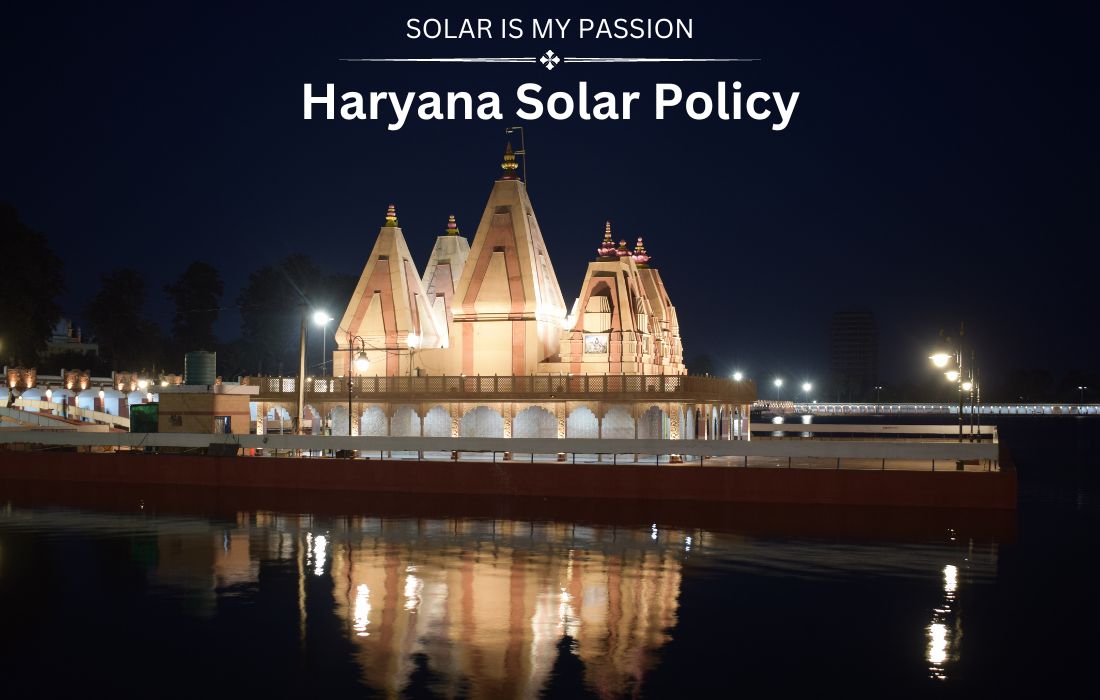No. 19/4/2016-5 Power.-The Government of Haryana has formulated Haryana Solar Power Policy 2016 to promote the generation of power from solar energy. Forgiving effect to this Policy, necessary amendments in various policies, rules and regulations, wherever necessary, shall be expeditiously undertaken by the concerned Department.
1. SHORT TITLE, COMMENCEMENT AND SCOPE
1.1 These Regulations shall be called ‘The Haryana Electricity Regulatory Commission (Rooftop Solar Grid Interactive System based on Net Metering) Regulations, 2014’.
1.2 These Regulations shall come into force from the date of publication in the Official Gazette of Haryana.
1.3 These Regulations shall apply to the distribution licensees and consumers of electricity of distribution licensees of the State of Haryana.
2. DEFINITIONS AND INTERPRETATIONS
2.1 In these Regulations, unless the context otherwise requires,
a) “Act” means the Electricity Act, 2003 (36 of 2003) and subsequent amendments thereof;
b) “Agreement” means an agreement entered into by the distribution licensee and the consumer for net metering connection;
c) “billing cycle or billing period” means the period for which regular electricity bills as specified by the Commission, are prepared for different categories of consumers by the licensee;
d) “Commission” means the Haryana Electricity Regulatory Commission constituted under the Act;
e) “contracted load” or “contract demand” means the maximum demand in kW or kVA, agreed to be supplied by the licensee and indicated in the agreement executed between the licensee and the consumer;
f) “Electricity Supply Code” means the Electricity Supply Code specified by the Haryana Electricity Regulatory Commission under Section 50 of the Act and subsequent amendments/re-enactments thereof;
g) “eligible consumer” means a consumer of electricity in the area of supply of the licensee, who intends to install or has installed a rooftop solar system in his premises, to offset part or all of his own energy requirement;
h) “financial year” or “year” means the period beginning from the first day of April in a calendar year and ending with the thirty-first day of the March of the next year;
i) “high tension” means supply at high voltage or extra high voltage;
j) “interconnection point” means the interface of solar power generation facility under net metering arrangement with the network of the licensee and shall normally be the point where the meter is installed to measure the energy transfer between the licensee and the consumer;
k) “licensee” means a distribution licensee as defined in the Act;
l) “low tension” means supply at low voltage or medium voltage;
m) “net metering” means an arrangement of energy metering under which a rooftop solar system installed at an eligible consumer’s premises delivers solar power simultaneously with the power supplied by the licensee to the consumer’s premises and the net consumption after off-setting the power generated by the solar power system is measured and displayed for the applicable billing period;
n) “obligated entity” means the entity mandated under clause (e) of subsection (1) of section 86 of the Act to fulfill the renewable purchase obligation and identified under the Haryana Electricity Regulatory Commission (Terms and Conditions for determination of Tariff from Renewable Energy Sources, Renewable Purchase Obligation and Renewable Energy Certificate) Regulations, 2010 and subsequent amendments/re-enactments thereof;
o) “premises” means rooftops or/and any area on the land, building or infrastructure or part or combination thereof in respect of which a separate meter or metering arrangements have been made by the licensee for supply of electricity;
p) “rooftop solar system” means the solar photovoltaic power system installed on any part of a consumer’s premises that uses solar energy for its direct conversion into electricity;
q) “Renewable Energy Certificate (REC)” means the certificate issued in accordance with the procedures prescribed in the Central Electricity Regulatory Commission (Terms and Conditions for recognition and issuance of Renewable Energy Certificate for Renewable Energy Generation) Regulations, 2010 and subsequent amendments thereof.
r) “settlement period” means the period beginning from first of April in a calendar year and ending with the thirty-first of the March of the next year i.e same as ‘financial year’;
s) “tariff order” in respect of a licensee means the most recent order issued by the Commission for that licensee indicating the rates to be charged by the licensee from various categories of consumers for the supply of electrical energy and services;
2.2 All other words and expressions used in these Regulations although not specifically defined herein above, but defined in the Act, shall have the meaning assigned to them in the Act. The other words and expressions used herein but not specifically defined in these Regulations or in the Act but defined under any law passed by the Parliament / State Legislation applicable to the electricity industry in the State shall have the meaning assigned to them in such law.
Objectives of the Haryana Solar Policy
The objectives of this policy are to:
1.6.1 To promote the generation of green and clean power in the State using solar energy.
1.6.2 To create conditions conducive to the participation of the private and public sectors as well as PPP in the promotion and setting up of up Solar Energy based power projects in the State.
1.6.3 Productive use of wastelands/non – agricultural lands thereby leading to socio-economic transformation and a reduction in regional disparities in development.
1.6.4 Employment generation and skill up-gradation of the youth.
1.6.5 To put in place an appropriate investment climate that would leverage the benefits of the Clean Development Mechanism (CDM) and result in lower Green House Gas (GHG) emissions.
1.6.6 Co-creation of Solar Centres of Excellence and pools of technical professionals which would work towards applied research and commercialization of indigenous and cutting-edge technologies involving applications of solar energy generation and appliances.
1.6.7 Spreading of environmental consciousness among all citizens of the State especially the youth and school-going children.
1.6.8 Decentralization and diversification of the energy portfolio and increasing the share of renewable solar power.
ROOFTOP SOLAR SUBSIDY (DBT SCHEME) BY MNRE NATIONAL PORTAL – STEP-BY-STEP PROCESS
DISCOM links are below:


